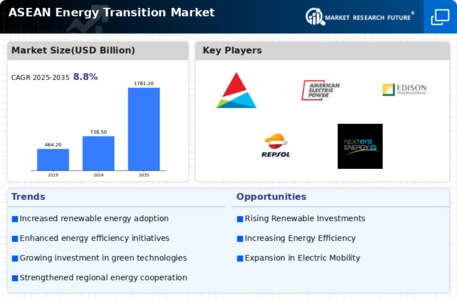Government Policies and Incentives
The ASEAN Energy Transition Market is significantly influenced by government policies and incentives aimed at promoting renewable energy adoption. Various ASEAN nations have implemented feed-in tariffs, tax breaks, and subsidies to encourage investments in clean energy technologies. For instance, countries like Indonesia and Vietnam have established ambitious renewable energy targets, aiming for 23% and 20% of their energy mix from renewables by 2025, respectively. These policies not only stimulate local investments but also attract foreign direct investment, thereby enhancing the overall market landscape. The commitment of governments to reduce carbon emissions and transition towards sustainable energy sources is likely to drive growth in the ASEAN Energy Transition Market.
Rising Energy Demand and Urbanization
The rapid urbanization and rising energy demand in ASEAN countries are driving the need for a transition to sustainable energy solutions. As urban populations grow, the demand for electricity is expected to increase significantly, with projections indicating a rise of 6% annually in energy consumption across the region. This surge in demand necessitates a shift from traditional fossil fuels to renewable energy sources to ensure energy security and sustainability. The ASEAN Energy Transition Market is likely to benefit from this trend, as governments and private sectors seek to develop infrastructure that supports renewable energy generation and distribution. The interplay between urbanization and energy demand presents both challenges and opportunities for the ASEAN Energy Transition Market.
Investment in Infrastructure Development
Investment in infrastructure development is a pivotal driver for the ASEAN Energy Transition Market. The region is experiencing a wave of infrastructure projects aimed at enhancing energy generation and distribution capabilities. Governments are prioritizing investments in renewable energy facilities, smart grids, and transmission networks to accommodate the growing share of renewables in their energy mix. For example, the Asian Development Bank has committed substantial funding to support renewable energy projects across ASEAN nations. This influx of capital is expected to facilitate the construction of new energy facilities and the modernization of existing infrastructure, thereby bolstering the ASEAN Energy Transition Market. The focus on infrastructure development is likely to create a more resilient and efficient energy system in the region.
Technological Advancements in Energy Storage
Technological advancements in energy storage solutions are poised to play a crucial role in the ASEAN Energy Transition Market. Innovations in battery technologies, such as lithium-ion and solid-state batteries, are enhancing the efficiency and reliability of renewable energy systems. The region is witnessing a surge in energy storage projects, with countries like Thailand and Malaysia investing in large-scale battery storage systems to stabilize their grids. According to recent data, the energy storage market in ASEAN is projected to grow at a compound annual growth rate of over 20% in the coming years. This growth indicates a strong potential for energy storage technologies to support the integration of renewable energy sources, thereby facilitating a smoother transition in the ASEAN Energy Transition Market.
Public Awareness and Consumer Demand for Sustainability
Public awareness regarding climate change and the demand for sustainable energy solutions are increasingly shaping the ASEAN Energy Transition Market. As consumers become more environmentally conscious, there is a growing preference for renewable energy sources. Surveys indicate that a significant percentage of the population in ASEAN countries is willing to pay a premium for green energy options. This shift in consumer behavior is prompting energy providers to diversify their offerings and invest in renewable energy projects. The rise in demand for sustainable energy solutions is likely to encourage innovation and competition within the ASEAN Energy Transition Market, ultimately leading to a more sustainable energy landscape.

















Leave a Comment